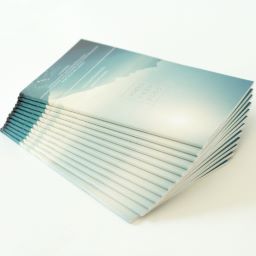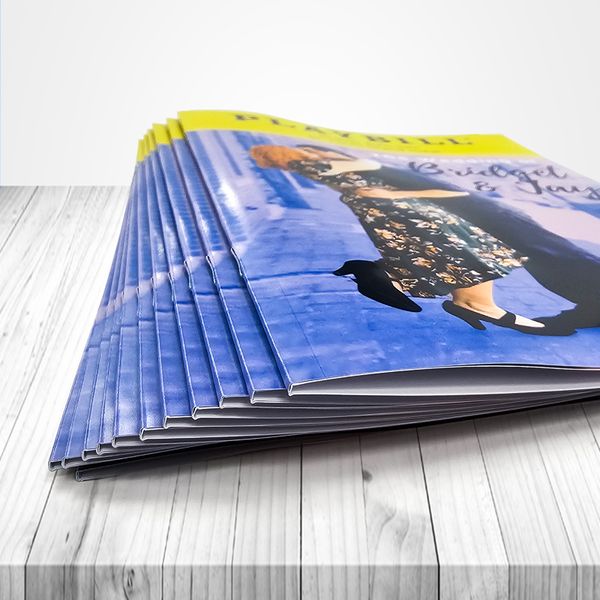Exploring Industry Trends That Are Shaping the Future of Booklet Printing
Exploring Industry Trends That Are Shaping the Future of Booklet Printing
Blog Article
The Crucial Overview to Recognizing Booklet Printing Options and Techniques
The process of brochure printing involves several factors to consider that can significantly affect the last item. From selecting the suitable layout and dimension to understanding the subtleties of binding approaches, each option plays a vital role. In addition, aspects such as paper supply and printing strategies more influence the efficiency of the booklet. As one browses these alternatives, it comes to be critical to realize how they adjoin and what that suggests for the overall outcome.
Comprehending Booklet Dimensions and layouts
When considering booklet printing, understanding the various formats and dimensions readily available is essential for accomplishing the desired presentation. Pamphlets can be produced in countless formats, consisting of saddle-stitched, spiral-bound, and perfect-bound, each offering unique advantages. Typical sizes range from standard letter (8.5 x 11 inches) to smaller alternatives like A5 (5.8 x 8.3 inches), enabling flexibility based on material and target audience.Selecting the ideal dimension can affect both the design and visitor interaction. Larger sizes could match visually driven web content, while smaller formats may be more user-friendly and portable. Furthermore, the number of pages influences the option of binding approach, as thicker pamphlets may call for tougher bindings. Ultimately, understanding these aspects permits a much more tailored strategy, making certain that the final product lines up with the desired message and visual, improving the general performance of the interaction.
Selecting the Right Paper Supply

Binding Techniques: Alternatives and Factors To Consider
When it involves binding approaches for brochures, several alternatives are offered, each with distinct advantages. Saddle stitch binding uses an economical solution for thinner pamphlets, while excellent binding strategies provide a more sleek search for thicker magazines. Wire-O binding stands apart for its toughness and convenience of usage, making it ideal for documents that need adaptability.
Saddle Stitch Binding
Saddle stitch binding provides a functional and affordable solution for putting together brochures, making it a popular selection among authors and organizations. This binding technique includes folding sheets of paper in half and stapling them along the fold line, developing a orderly and cool look. Normally appropriate for brochures with a lower web page count, saddle stitching is suitable for publications, brochures, and training materials. The simpleness of this method permits for fast manufacturing and is typically preferred for promotional items or brief runs. It is important to note that saddle stitch binding may not be ideal for thicker booklets, as the spinal column might not hold up under enhanced weight. Generally, it remains a trustworthy option for several printing projects.
Perfect Binding Techniques
Perfect binding is a widely made use of technique that provides a specialist and refined finish to booklets and publications. This approach involves gluing the pages together at the back making use of a solid adhesive, permitting a clean side and the capacity to hold a bigger number of web pages contrasted to saddle stitching. Perfect binding is specifically suitable for thicker brochures, such as magazines and annual records, where a sturdy, flat spinal column is desired. In addition, it uses the alternative for a printed cover that can be created to improve aesthetic allure. Nonetheless, considerations such as page count, paper weight, and the intended use of the brochure need to be considered, as they can impact resilience and general top quality.
Wire-O Binding Choices
Wire-O binding, recognized for its sturdiness and flexibility, supplies an exceptional choice for booklets that call for easy web page turning and a specialist look. This binding technique uses a series of metal loopholes that hold pages securely, enabling them to exist level when open. It is specifically suitable for magazines, discussions, and guidebooks as a result of its durable nature. Wire-O binding is offered in different shades and sizes, fitting various web page matters and thicknesses. Furthermore, it allows the incorporation of covers and tabs, enhancing the booklet's general visual. Considerations for Wire-O binding include the choice of cord color, the size of the loops, and the level of modification wanted, every one of which can greatly affect the last item's appearance and performance.
Digital vs. Offset Printing: Which Is Best for You?
When picking a printing approach for booklets, understanding the distinctions between digital and offset printing is necessary. Digital printing utilizes modern-day innovation to create top quality prints swiftly and economically, making it suitable for brief runs or projects calling for quick turn-around times. It permits for modification, providing the capability to publish on-demand with marginal waste.In comparison, offset printing is a traditional technique that stands out in creating big quantities with constant quality. It includes moving ink from a plate to a rubber covering, then to the paper, which causes precise information and lively colors. Nevertheless, counter find this printing generally needs longer arrangement times and is much more cost-effective for bigger volumes.Ultimately, the choice between electronic and balance out printing depends on project requirements, budget, and desired amount. For tiny, time-sensitive tasks, electronic may be the very best selection, while countered may be better for larger, high-quality productions.

Designing Your Brochure: Tips and Ideal Practices
When developing a pamphlet, cautious focus to layout, typeface option, and color use can substantially improve its effectiveness. A well-structured layout overviews the reader's eye, while ideal typefaces guarantee readability and communicate the preferred tone. Furthermore, efficient use of color can evoke feelings and highlight essential information, making the overall layout extra impactful.
Choosing the Right Layout
Just how can one properly choose the best format for a booklet? It is vital to examine the pamphlet's purpose and target audience. A tidy, arranged format boosts readability and involvement. Utilizing a grid system can assist in aligning components continually, creating a specialist appearance. In addition, including aesthetic pecking order with varying dimensions and placements of photos and text can lead the viewers's eye and emphasize vital information. It is additionally crucial to leave adequate white room, which stops congestion and enables much better focus. Checking different designs with mock-ups can provide understanding into how the layout carries out in real-world circumstances, making certain that the last item satisfies both aesthetic and practical demands.
Selecting Appropriate Font Styles
An appropriate typeface can substantially improve the total design of a pamphlet, enhancing the layout and reinforcing the web content's message. The selection of fonts ought to think about readability, particularly for body text, as it guarantees the details is obtainable to all readers. Sans-serif font styles are typically favored for electronic layouts, while serif typefaces can provide a standard feeling in printed materials. It's advisable to restrict font selections to 2 or three to maintain visual comprehensibility. In addition, font size plays an essential role; headings should be not overwhelming yet distinct, while body message must fit for reading. When selecting typefaces, positioning with the brochure's theme and target market is crucial for efficient communication and visual allure.
Efficient Use of Shade
Color serves as an effective device in pamphlet layout, leading and shaping assumptions reader feelings. It can evoke feelings of count on, enjoyment, or peace, depending on the colors selected. Designers must take into consideration color concept concepts, ensuring that the selected combination straightens with the booklet's message and target audience. Making use of warm colors like red and orange can create urgency, while cooler tones like environment-friendly and blue foster tranquility.Additionally, comparison plays an essential role; complementary colors can enhance readability and visual appeal. Consistency in color usage across pages even more enhances brand name identification and communication. Eventually, efficient shade application not only catches interest however likewise strengthens the brochure's objective, making it an important facet of effective design.
Finishing Touches: Coatings and Special Effects
While many consider the content and layout of a pamphlet one of the most critical components, the finishing touches, such as finishes and unique effects, play a vital duty in enhancing its overall charm. Coatings can supply defense and resilience, making sure that the pamphlet holds up against deterioration. Matte finishes supply an innovative, non-reflective surface, while glossy coverings can make colors show up more vibrant and eye-catching. Special effects, like embossing or aluminum foil stamping, include a tactile dimension that can develop an unforgettable impact. These methods can highlight particular locations, accentuating crucial information or developing visual passion. Furthermore, UV covering can give a high-shine surface that boosts the general look.Together, these finishing touches not only boost the brochure's visual however additionally interact professionalism and focus to detail, eventually leaving a lasting effect on the reader.
Expense Factors To Consider for Booklet Printing
Recognizing the various expense factors to consider for booklet printing is crucial for companies and companies intending to maximize their budgets. Secret variables influencing expenses consist of the choice of paper, ink, and binding techniques. Better materials, such as here premium paper or specialized inks, normally raise the overall expense. Furthermore, the dimension and page count of the pamphlet play a considerable function; bigger brochures call for more sources and time to produce.Another essential consideration is the printing method, whether digital or balanced out, as each has its very own prices framework and suitability for various quantities. Services need to likewise consider design expenses, which can differ based on complexity and using professional solutions. Inevitably, shipping and handling charges can include in the total amount, especially for large orders. By assessing these aspects, organizations can make educated decisions that align with their financial capabilities while achieving the wanted top quality in their published products.
Often Asked Concerns
What Are the Environmental Impacts of Pamphlet Printing?
The ecological effects of brochure printing include deforestation from paper manufacturing, carbon discharges from transportation, Source and waste generation from discarded products - Booklet Printing. Lasting methods, such as using recycled paper and environmentally friendly inks, can reduce these effects
Just How Can I Make Sure Color Accuracy in My Pamphlet?
To ensure color precision in a brochure, one ought to make use of adjusted monitors, use specialist color accounts, carry out test prints, and pick high-grade printing services that offer shade matching and proofing choices for ideal outcomes.
What Is the Typical Turn-around Time for Brochure Printing?
The typical turn-around time for brochure printing varies relying on the complexity and amount - Booklet Printing. Typically, it varies from a few days to 2 weeks, influenced by variables such as printing methods and completing requirements
Exist Minimum Order Quantities for Booklet Printing?

Can I Publish Booklets in Numerous Languages?
Printing brochures in multiple languages is possible. Several printing services supply choices for multilingual or bilingual layouts, enabling for effective interaction. Mindful preparation guarantees that make components accommodate various languages without compromising readability or appearances. In addition, factors such as paper stock and printing techniques further influence the effectiveness of the booklet. When considering booklet printing, understanding the various formats and sizes available is vital for accomplishing the preferred presentation. When selecting a printing method for booklets, understanding the distinctions in between electronic and balance out printing is vital. Furthermore, the size and page count of the pamphlet play a substantial duty; larger booklets require even more sources and time to produce.Another crucial consideration is the printing technique, whether electronic or balanced out, as each has its own pricing framework and viability for different amounts. The ecological effects of booklet printing consist of logging from paper production, carbon exhausts from transport, and waste generation from discarded products.
Report this page